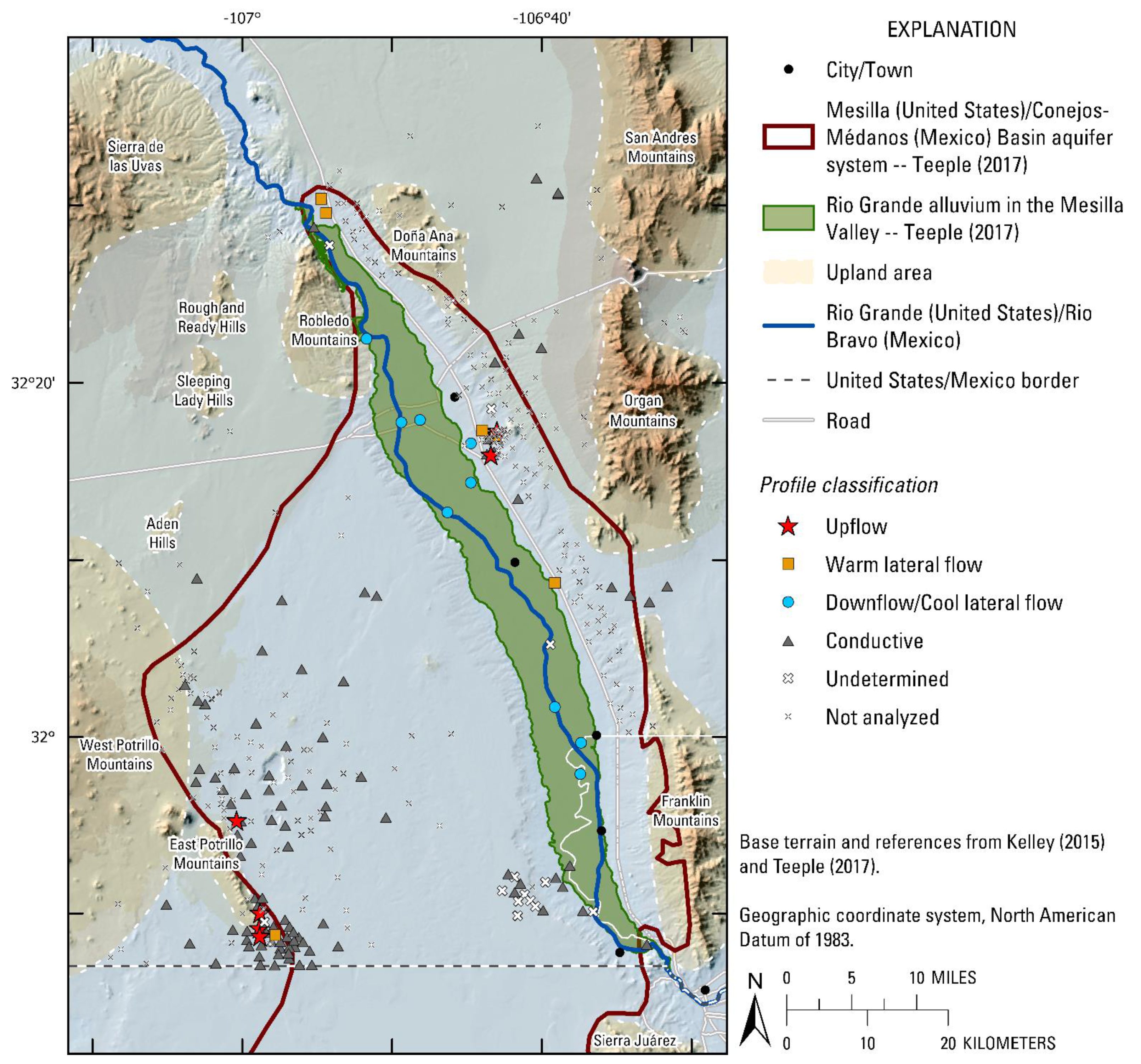Salinity Contributions from Geothermal Waters to the Rio Grande and Shallow Aquifer System in the Transboundary Mesilla (United States)/Conejos-Médanos (Mexico) Basin
Abstract
:1. Introduction

2. Background
2.1. Description of the Study Area
2.2. Known Geothermal Systems within the Study Area
2.3. Using Heat as a Groundwater Tracer
3. Materials and Methods
3.1. Description of Data
3.2. Classification Analysis
3.3. Flux Estimation
4. Results
4.1. Classifications
4.2. Flux Estimates
4.2.1. East Mesa Upflow
4.2.2. East Potrillo Upflow
5. Discussion
- Upland precipitation infiltrates;
- Infiltrated groundwater is heated by the Earth’s natural geothermal gradient as it flows deeper within the Earth’s crust;
- Salinity of heated waters increases as the groundwater interacts with sediments and rocks along its flowpath;
- Resulting brackish waters discharge at regional topographic lows, through zones of enhanced permeability (commonly caused by faults), and/or through gaps in overlying lower-permeability stratigraphic layers.
Limitations
- Sparse data availability affecting the ability to comprehensively identify upflow zones and more accurately estimate upflow areas;
- Misidentification of profile curvature. For example, upflow profile curvature can look very similar to the upper half of profiles showing warm lateral flow (see Figure 2);
- Coupling computed 1D vertical fluxes to entire areas of upflow when estimating volumetric fluxes;
- Potential lateral flow effects in profiles with dominant upflow curvature;
- Non-steady state conditions of groundwater flow and temperature in the subsurface over the period of investigation (1972–2018).
6. Conclusions
Supplementary Materials
Author Contributions
Funding
Institutional Review Board Statement
Informed Consent Statement
Data Availability Statement
Acknowledgments
Conflicts of Interest
References
- National Oceanic and Atmospheric Administration (NOAA)—National Centers for Environmental Information—North American Drought Monitor. Available online: https://www.ncdc.noaa.gov/temp-and-precip/drought/nadm/ (accessed on 29 April 2021).
- Alley, W.M. Five-Year Interim, Report of the United States—Mexico Transboundary Aquifer Assessment Program: 2007–2012; U.S. Geological Survey Open-File Report; U.S. Department of the Interior: Washington, DC, USA, 2013; 31p. [CrossRef]
- Hogan, J.F.; Phillips, F.M.; Mills, S.K.; Hendrickx, J.M.H.; Ruiz, J.; Chesley, J.T.; Asmerom, Y. Geologic origins of salinization in semi-arid river: The role of sedimentary basin brines. Geology 2007, 35, 1063–1066. [Google Scholar] [CrossRef]
- Driscoll, J.M.; Sherson, L.R. Variability of Surface-Water Quantity and Quality and Shallow Groundwater Levels and Quality within the Rio Grande Project Area, New Mexico and Texas, 2009–2013; U.S. Geological Survey Scientific Investigations Report; USGS: Reston, VA, USA, 2016; 33p. [CrossRef]
- Phillips, F.M.; Mills, S.; Hendrickx, M.H.; Hogan, J. Environmental tracers applied to quantifying causes of salinity in arid-region rivers: Results from the Rio Grande Basin, Southwestern USA. Dev. Water Sci. 2003, 50, 327–334. [Google Scholar] [CrossRef]
- Witcher, J.C.; King, J.P.; Hawley, J.W.; Kennedy, J.F.; Williams, J.; Cleary, M.; Bothern, L.R. Sources of Salinity in the Rio Grande and Mesilla Basin Groundwater; New Mexico Water Resources Institute Technical Completion Report; 2004; 168p. Available online: https://nmwrri.nmsu.edu/tr-330/ (accessed on 1 May 2021).
- Moore, S.J.; Bassett, R.L.; Liu, B.; Wolf, C.P.; Doremus, D. Geochemical tracers to evaluate hydrogeologic controls on river salinization. Ground Water 2008, 46, 489–501. [Google Scholar] [CrossRef] [PubMed]
- Szynkiewicz, A.; Witcher, J.C.; Modelska, M.; Borrok, D.M.; Pratt, L.M. Anthropogenic sulphate loads in the Rio Grande, New Mexico (USA). Chem. Geol. 2011, 283, 194–209. [Google Scholar] [CrossRef]
- Moyer, D.L.; Anderholm, S.K.; Hogan, J.F.; Phillips, F.M.; Hibbs, B.J.; Witcher, J.C.; Matherne, A.M.; Falk, S.E. Knowledge and Understanding of Dissolved Solids in the Rio Grande—San Acacia, New Mexico, to Fort Quitman, Texas, and Plan for Future Studies and Monitoring; U.S. Geological Survey Open-File Report; USGS: Reston, VA, USA, 2013; 67p. [CrossRef] [Green Version]
- Hiebing, M.; Doser, D.I.; Avila, V.M.; Ma, L. Geophysical studies of fault and bedrock control on groundwater geochemistry within the southern Mesilla Basin, western Texas and southern New Mexico. Geosphere 2018, 14, 1912–1934. [Google Scholar] [CrossRef]
- Kubicki, C.; Carroll, K.C.; Witcher, J.C.; Robertson, A. An Integrated Geochemical Approach for Defining Sources of Groundwater Salinity in the Southern Rio Grande Valley of the Mesilla Basin, New Mexico and West Texas, USA; Desalination and Water Purification Research Program—Research and Development Office Report/New Mexico Water Resources Research Institute Technical Completion Report; 2021; 82p. Available online: https://nmwrri.nmsu.edu/tr-388/ (accessed on 1 May 2021).
- Snyder, J.T. Heat Flow in the Southern Mesilla Basin with an Analysis of the East Potrillo Geothermal System, Dona Ana County, New Mexico. Master’s Thesis, New Mexico State University, Las Cruces, NM, USA, May 1986. [Google Scholar]
- Witcher, J.C. A Geothermal Resource Data Base—New Mexico. New Mexico State University—Southwest Technology Development Institute Report; 1995; 94p. Available online: https://digital.library.unt.edu/ark:/67531/metadc665986/m2/1/high_res_d/204690.pdf (accessed on 1 May 2021).
- Lund, J.W. Radium Hot Springs. GHC Bull. 2002, 23, 48–49. Available online: https://www.osti.gov/servlets/purl/1209492 (accessed on 1 May 2021).
- Witcher, J.C.; Cunniff, R.A. Geothermal Energy at New Mexico State University in Las Cruces. GHC Bull. 2002, 23, 30–36. Available online: https://www.osti.gov/servlets/purl/1209492 (accessed on 1 May 2021).
- Witcher, J.C.; Lund, J.W. Masson Radium Springs Farm. GHC Bull. 2002, 23, 42–44. Available online: https://www.osti.gov/servlets/purl/1209492 (accessed on 1 May 2021).
- Frenzel, P.F.; Kaehler, C.A.; Anderholm, S.K. Geohydrology and Simulation of Ground-Water Flow in the Mesilla Basin, Dona Ana County, New Mexico, and El Paso County, Texas, with a Section on Water Quality and Geochemistry; U.S. Geological Survey Professional Paper; USGS: Reston, VA, USA, 1992. [CrossRef]
- Pepin, J.D.; Robertson, A.J.; Kelley, S.A. Borehole Temperature Profiles Measured in the Mesilla Basin, New Mexico during the Period 1972 through 2018; U.S. Geological Survey Data Release; USGS: Reston, VA, USA, 2019. [CrossRef]
- Anderson, M.P. Heat as a ground water tracer. Ground Water 2005, 43, 951–968. [Google Scholar] [CrossRef] [PubMed]
- Robertson, A.J.; Matherne, A.M.; Pepin, J.D.; Ritchie, A.; Sweetkind, D.S.; Teeple, A.P.; Granados-Olivas, A.; Garcia Vasquez, A.C.; Carroll, K.C.; Fuchs, E.H.; et al. Mesilla/Conejos-Médanos Basin: U.S.-Mexico Transboundary Water Resources and Research Needs. Water 2021. under revision. [Google Scholar]
- Teeple, A.P. Geophysics- and Geochemistry-Based Assessment of the Geochemical Characteristics and Groundwater-Flow System of the U.S. Part of the Mesilla Basin/Conejos-Médanos Aquifer System in Doña Ana County, New Mexico, and El Paso County, Texas, 2010–2012; U.S. Geological Survey Scientific Investigations Report; USGS: Reston, VA, USA, 2017; 183p. [CrossRef]
- Kelley, R. New Mexico Geothermal Play Fairway Analysis from LANL. Geothermal Data Repository. 2015. Available online: https://gdr.openei.org/submissions/597 (accessed on 29 April 2021).
- U.S. Geological Survey [USGS]. USGS Water Data for the Nation; U.S. Geological Survey National Water Information System Database; USGS: Reston, VA, USA, 2021. [CrossRef]
- Chapin, C.E.; Seager, W.R. Evolution of the Rio Grande rift in the Socorro and Las Cruces areas. In 26th Annual Fall Field Conference Guidebook; Seager, W.R., Clemons, R.E., Callender, J.F., Eds.; New Mexico Geological Society: Socorro, NM, USA, 1975; pp. 297–321. [Google Scholar]
- Hawley, J.W. Guidebook to the Rio Grande Rift in New Mexico and Colorado; New Mexico Bureau of Mines and Mineral Resources Circular; New Mexico Bureau of Mines and Mineral Resources: Socorro, NM, USA, 1978; 241p. [Google Scholar]
- Chapin, C.E.; Cather, S.M. Tectonic setting of the axial basins of the northern and central Rio Grande rift. In Basins of the Rio Grande Rift—Structure, Stratigraphy, and Tectonic Setting; Keller, G.R., Cather, S.M., Eds.; Geological Society of America: Boulder, CO, USA, 1994; pp. 5–25. [Google Scholar] [CrossRef]
- Sweetkind, D.S. Three-Dimensional Hydrogeologic Framework Model of the Rio Grande Transboundary Region of New Mexico and Texas, USA, and Northern Chihuahua, Mexico; U.S. Geological Survey Scientific Investigations Report; USGS: Reston, VA, USA, 2017; 49p. [CrossRef] [Green Version]
- Hoffer, J.M. Geology of Potrillo Basalt Field, South-Central New Mexico; New Mexico Bureau of Geology and Mineral Resources Circular; New Mexico Bureau of Mines and Mineral Resources: Socorro, NM, USA, 1976; 30p. [Google Scholar]
- Servicio Geológico Mexicano. Hydrogeological Activities in the Conejos-Medanos/Mesilla Basin Aquifer, Chihuahua, Phase 1; Servicio Geológico Mexicano Report; Servicio Geológico Mexicano: Pachuca, Hidalgo, 2010; Volume 1, 467p. [Google Scholar]
- LeRoy, S.; Garfin, G. Climate Assessment for the Southwest (CLIMAS)—The Climate of Las Cruces; University of Arizona: Tucson, NM, USA, 2017; 24p. [Google Scholar]
- Hanson, R.T.; Ritchie, A.B.; Boyce, S.E.; Galanter, A.E.; Ferguson, I.A.; Flint, L.E.; Flint, A.; Henson, W.R. Rio Grande Transboundary Integrated Hydrologic Model and Water-Availability Analysis, New Mexico and Texas, United States, and Northern Chihuahua, Mexico; U.S. Geological Survey Scientific Investigations Report; USGS: Reston, VA, USA, 2020; 186p. [CrossRef] [Green Version]
- Gross, J.T.; Giordano, T.H. The Las Cruces Geothermal Field—A flow model [Abstract]. New Mex. Geol. 1985, 7, 64. [Google Scholar]
- Sorey, M.L. Measurement of vertical groundwater velocity from temperature profiles in wells. Water Resour. Res. 1971, 7, 963–970. [Google Scholar] [CrossRef]
- Boyle, J.M.; Saleem, Z.A. Determination of recharge rates using temperature-depth profiles in wells. Water Resour. Res. 1979, 15, 1616–1622. [Google Scholar] [CrossRef]
- Irvine, D.J.; Cartwright, I.; Post, V.E.A.; Simmons, C.T.; Banks, E.W. Uncertainties in vertical groundwater fluxes from 1-D steady state heat transport analyses caused by heterogeneity, multidimensional flow, and climate change. Water Resour. Res. 2016, 52, 813–826. [Google Scholar] [CrossRef] [Green Version]
- Wang, X. fANCOVA: Nonparametric Analysis of Covariance. R Package Version 0.5-1. 2010. Available online: https://CRAN.R-project.org/package=fANCOVA (accessed on 13 December 2021).
- R Core Team. R: A Language and Environment for Statistical Computing. R Foundation for Statistical Computing. 2019. Available online: https://www.R-project.org/ (accessed on 13 May 2021).
- Bredehoeft, J.D.; Papadopulos, I.S. Rates of vertical groundwater movement estimated from the Earth’s thermal profiles. Water Resour. Res. 1965, 1, 325–328. [Google Scholar] [CrossRef]
- Kell, G.S. Density, thermal expansivity, and compressibility of liquid water from 0° to 150 °C: Correlations and tables for atmospheric pressure and saturation reviewed and expressed on 1968 temperature scale. J. Chem. Eng. Data 1975, 20, 97–105. [Google Scholar] [CrossRef]
- Ingebritsen, S.E.; Sanford, W.E.; Neuzil, C.E. Groundwater in Geologic Processes, 2nd ed.; Cambridge University Press: New York, NY, USA, 2006; 536p. [Google Scholar]
- U.S. Geological Survey (USGS) 3D Elevation Program (3DEP). National Elevation Dataset (NED) Seamless Layers. Available online: http://ned.usgs.gov/about.html (accessed on 18 May 2021).
- Reiter, M.; Eggleston, R.E.; Broadwell, B.R.; Minier, J. Estimates of terrestrial heat flow from deep petroleum tests along the Rio Grande rift in Central and Southern New Mexico. J. Geophys. Res. 1986, 91, 6225–6245. [Google Scholar] [CrossRef]
- Witcher, J.C.; Reiter, M.; Bland, D.; Barroll, M.W. Geothermal resources in New Mexico. New Mex. Geol. 1992, 14–16. [Google Scholar]
- Faulds, J.E.; Hinz, N.H. Favorable Tectonic and Structural Settings of Geothermal Systems in the Great Basin Region, Western USA: Proxies for Discovering Blind Geothermal Systems. In Proceedings of the World Geothermal Congress, Melbourne, Australia, 19–24 April 2015; p. 6. Available online: https://www.osti.gov/servlets/purl/1724082 (accessed on 13 December 2021).
- Faulds, J.; Coolbaugh, M.; Bouchot, V.; Moek, I.; Oguz, K. Characterizing structural controls of geothermal reservoirs in the Great Basin, USA, and Western Turkey: Developing successful exploration strategies in extended terranes. In Proceedings of the World Geothermal Congress, Bali, Indonesia, 25–30 April 2010; pp. 1–11. [Google Scholar]
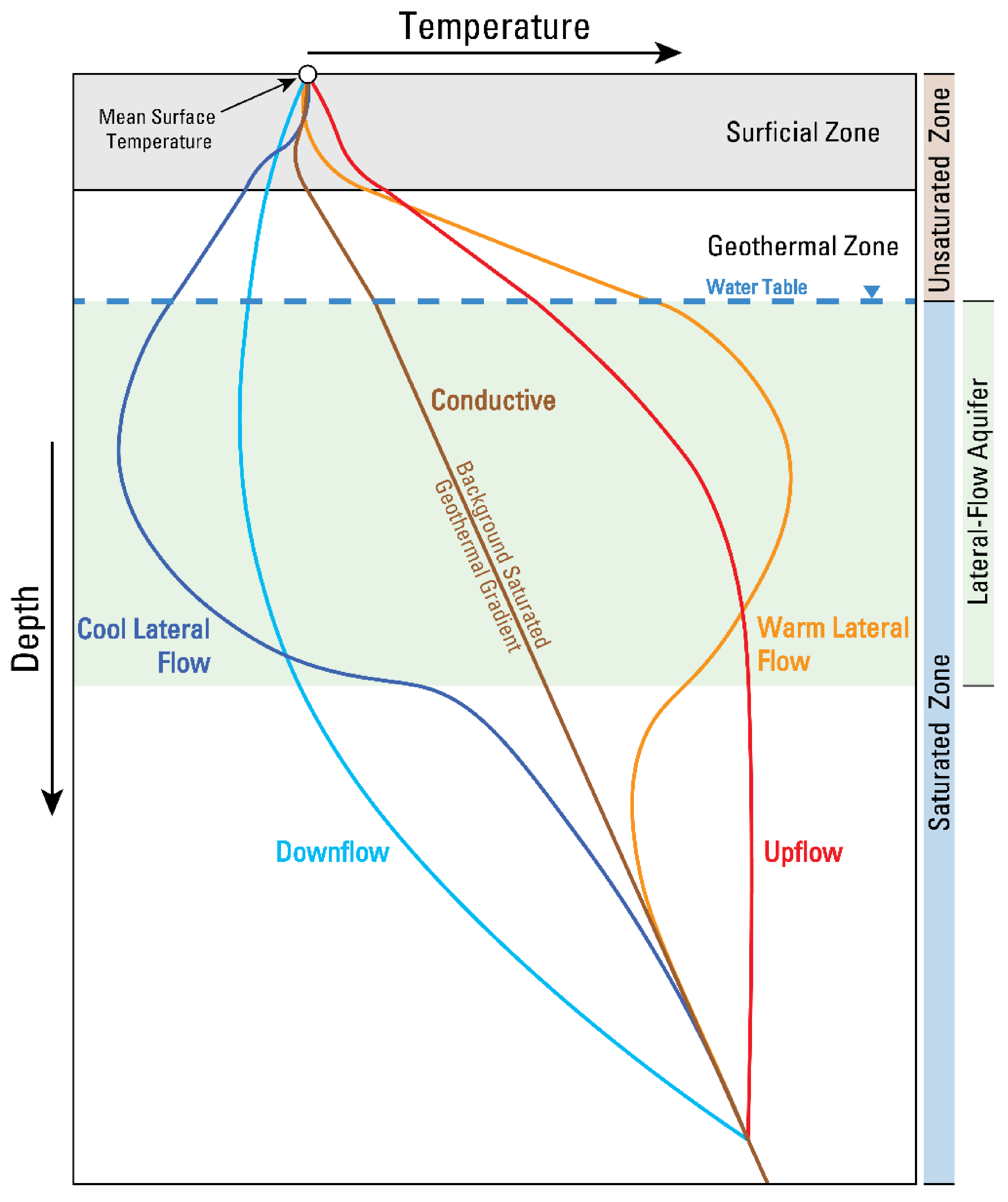
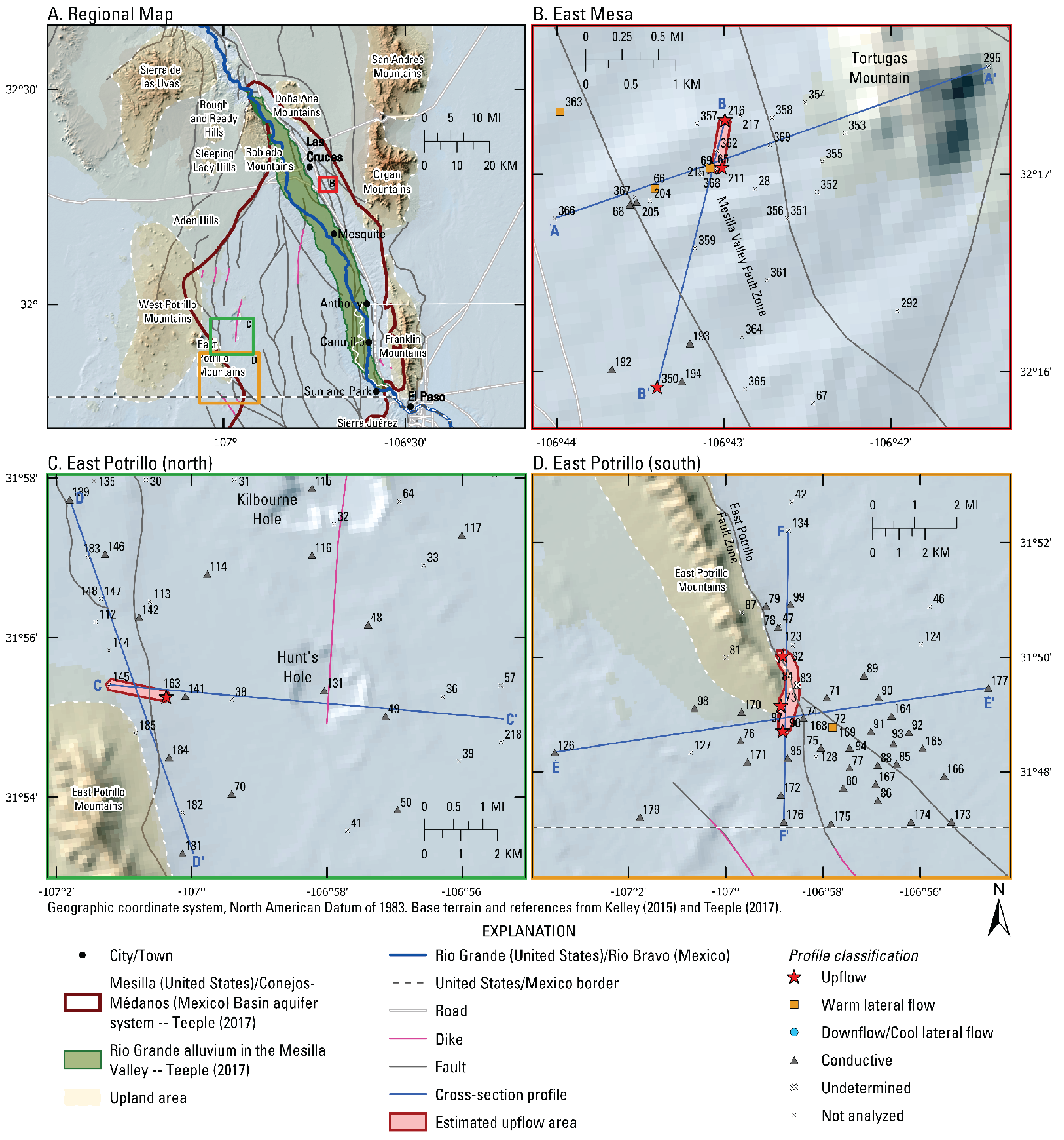

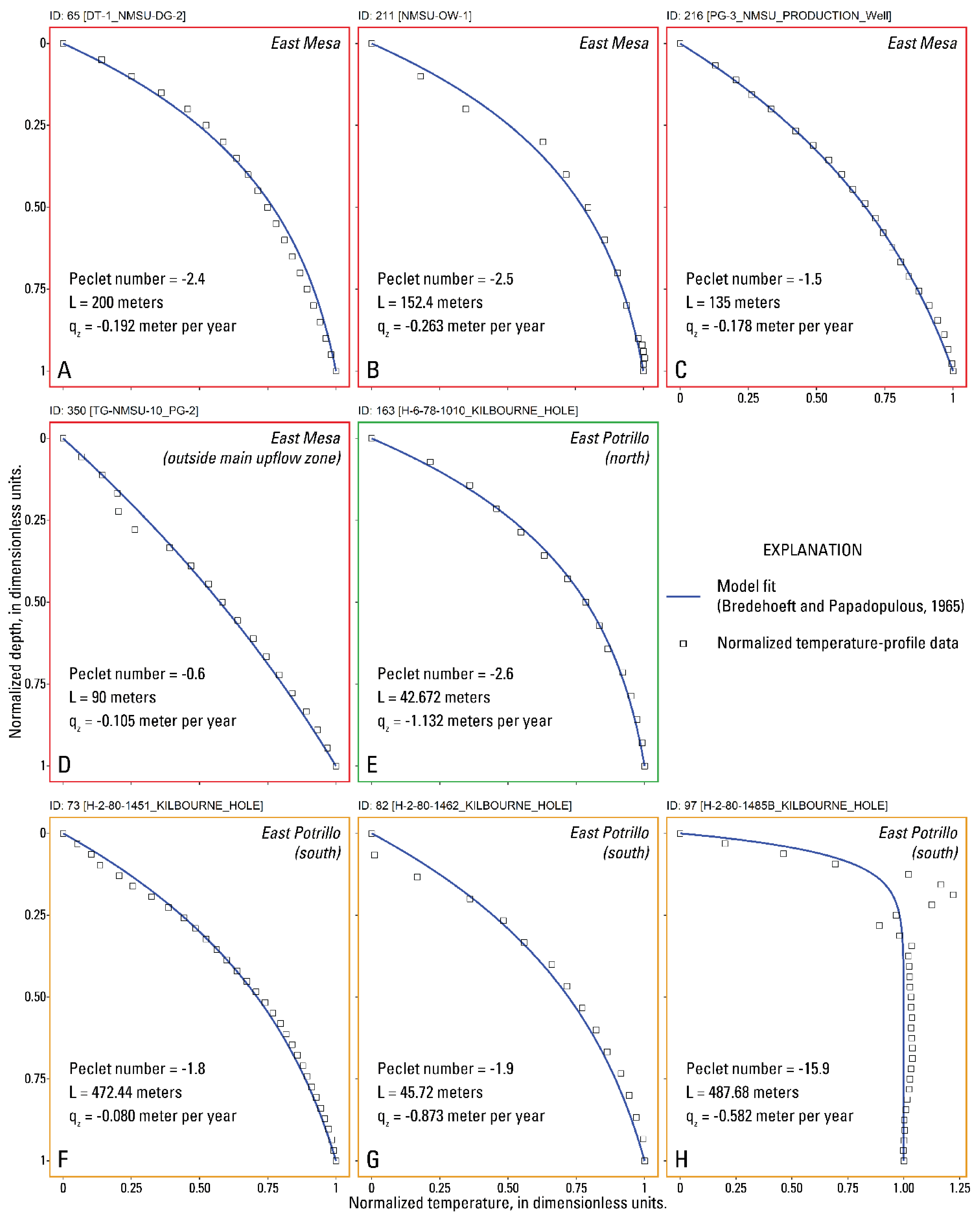
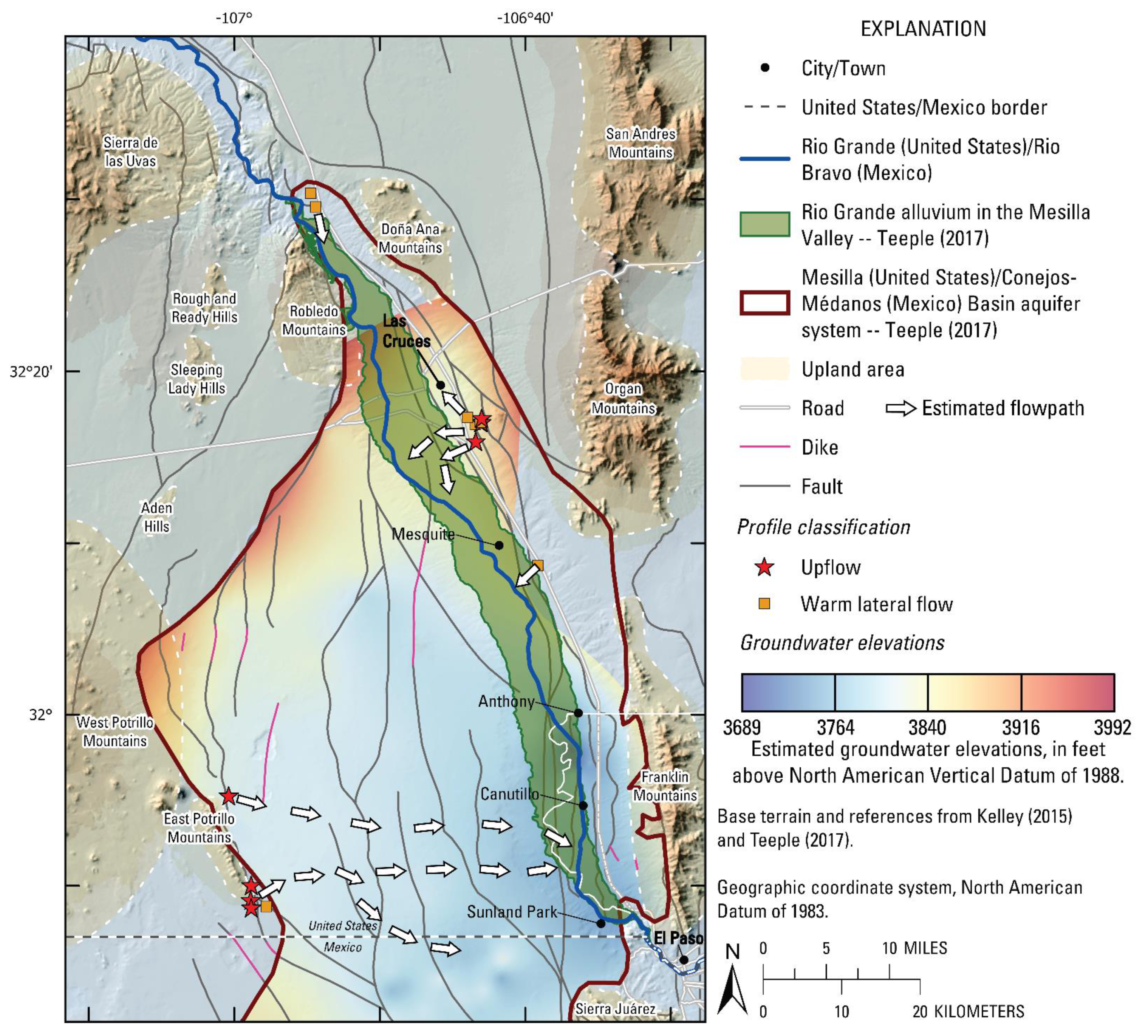
| Region | Subregion | ID | Ke | n | ρf | A | qz | Qz | JTDS |
|---|---|---|---|---|---|---|---|---|---|
| East Mesa | Main | 65 | 2.083 | 0.125 | 983.31 | 53,900 | −0.192 | 8.4 | 21 |
| Main | 211 | 2.084 | 0.125 | 981.86 | 53,900 | −0.263 | 11.5 | 28 | |
| Main | 216 | 2.084 | 0.125 | 982.59 | 53,900 | −0.178 | 7.8 | 19 | |
| Isolated | 350 | 2.076 | 0.125 | 991.05 | N/A1 | −0.105 | N/A1 | N/A1 | |
| East Potrillo | North | 163 | 2.45 | 0.25 | 995.01 | 361,700 | −1.132 | 332 | 2177 |
| South | 73 | 2.74 | 0.25 | 988.59 | 1,357,700 | −0.080 | 88 | 575 | |
| South | 82 | 2.74 | 0.20 | 983.98 | 1,357,700 | −0.873 | 961 | 6302 | |
| South | 97 | 2.33 | 0.20 | 984.24 | 1,357,700 | −0.582 | 641 | 4203 |
Publisher’s Note: MDPI stays neutral with regard to jurisdictional claims in published maps and institutional affiliations. |
© 2021 by the authors. Licensee MDPI, Basel, Switzerland. This article is an open access article distributed under the terms and conditions of the Creative Commons Attribution (CC BY) license (https://creativecommons.org/licenses/by/4.0/).
Share and Cite
Pepin, J.D.; Robertson, A.J.; Kelley, S.A. Salinity Contributions from Geothermal Waters to the Rio Grande and Shallow Aquifer System in the Transboundary Mesilla (United States)/Conejos-Médanos (Mexico) Basin. Water 2022, 14, 33. https://doi.org/10.3390/w14010033
Pepin JD, Robertson AJ, Kelley SA. Salinity Contributions from Geothermal Waters to the Rio Grande and Shallow Aquifer System in the Transboundary Mesilla (United States)/Conejos-Médanos (Mexico) Basin. Water. 2022; 14(1):33. https://doi.org/10.3390/w14010033
Chicago/Turabian StylePepin, Jeff D., Andrew J. Robertson, and Shari A. Kelley. 2022. "Salinity Contributions from Geothermal Waters to the Rio Grande and Shallow Aquifer System in the Transboundary Mesilla (United States)/Conejos-Médanos (Mexico) Basin" Water 14, no. 1: 33. https://doi.org/10.3390/w14010033





